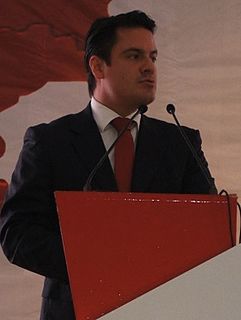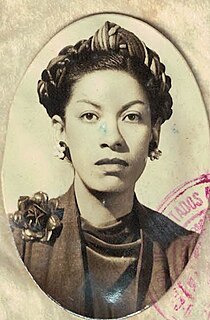
Guadalajara is the capital and largest city of the Mexican state of Jalisco, and the seat of the municipality of Guadalajara. The city is in the central region of Jalisco in the Western-Pacific area of Mexico. With a population of 1,460,148 inhabitants, it is Mexico's second most populous municipality. The Guadalajara metropolitan area has a reported population of 5,002,466 inhabitants, making it the second most populous metropolitan area in Mexico, behind Mexico City. The municipality is the second most densely populated in Mexico, the first being Ciudad Nezahualcóyotl in the State of Mexico. It is a strong business and economic center in the Bajío region.

The University of Guadalajara is a public higher education institution in the Mexican city of Guadalajara. The University has several high schools as well as graduate and undergraduate campuses, which are distributed all over the state of Jalisco, Mexico. It is regarded as the most significant university in the state and the second in the country, only behind the National Autonomous University of Mexico. Chronologically, based on its foundation, is the second oldest in Mexico, the seventeenth in North America and the fourteenth in Latin America.

The Universidad Autónoma de Guadalajara, commonly abbreviated to UAG or Autónoma, is a coeducational, independent, private university based in the Mexican city of Guadalajara. Established in 1935, it was the first private university and medical school in Mexico. The university was the result of the struggle against the communist and socialist laws and influence in the higher education of Mexico. It was first conceived with the name Universidad del Occidente, but would later be styled to Universidad Autónoma de Guadalajara (UAG).

The Jalisco Stadium is a football stadium located in Guadalajara, Mexico. It is the third largest Mexican football stadium behind Estadio Azteca and Estadio Olímpico Universitario. The facility is located in the city of Guadalajara, Jalisco, 400 kilometers north-west of Mexico City, and has a maximum capacity of 55,110 spectators.

Zapopan is a city and municipality located in the Mexican state of Jalisco. Part of the Guadalajara Metropolitan Area, the population of Zapopan city proper makes it the second largest city in the state, very close behind the population of Guadalajara proper. It is best known as being the home of the Virgin of Zapopan, an image of the Virgin Mary which was made in the 16th century. This image has been credited with a number of miracles and has been recognized by popes and even visited by Pope John Paul II. The municipality is also the home of the Centro Cultural Universitario, which contains one of the most important concert venues in Latin America and is the home of the new stadium for the C.D. Guadalajara.

Tonalá is a city and municipality within the Guadalajara Metropolitan Area in the state of Jalisco in Mexico. With a population of 374,258, it is the fourth largest city in the state, the other three being the other major population centres in the metro area: Guadalajara, Zapopan, and Tlaquepaque. It is best known as a major handcrafts center for Jalisco, especially pottery, as well as its very large Thursday and Sunday street market, dedicated to handcrafts.

The Guadalajara light rail system, which is operated by SITEUR, is a light rail system serving the municipalities of Guadalajara, Zapopan and Tlaquepaque, in the state of Jalisco, Mexico. It is owned by the state of Jalisco, and operator SITEUR is a state authority. Opened in 1989, the system currently has two lines: Line 1, running from north to south, with 19 stations, and Line 2, running from the city centre to the east, with 10 stations.

Western Institute of Technology and Higher Education — distinct from the state University of Guadalajara — is a Jesuit university in the Western Mexican state of Jalisco, located in the municipality of Tlaquepaque in the Guadalajara Metropolitan Area.

Jalisco, officially the Free and Sovereign State of Jalisco, is one of the 32 states which comprise the Federal Entities of Mexico. It is located in Western Mexico and is bordered by six states which are Nayarit, Zacatecas, Aguascalientes, Guanajuato, Michoacán and Colima. Jalisco is divided into 125 municipalities, and its capital city is Guadalajara. Jalisco is one of the most important states in Mexico because of its natural resources as well as its history. Many of the characteristic traits of Mexican culture, particularly outside Mexico City, are originally from Jalisco, such as mariachi, ranchera music, birria, tequila, jaripeo, etc., hence the state's motto: "Jalisco es México." Economically, it is ranked third in the country, with industries centered in the Guadalajara metropolitan area, the second largest metropolitan area in Mexico. The state is home to two significant indigenous populations, the Huichols and the Nahuas. There is also a significant foreign population, mostly from the United States and Canada, living in the Lake Chapala and Puerto Vallarta areas.
Jesús Guerrero Galván was a Mexican artist, a member of the Mexican muralism movement of the early 20th century. He began his career in Guadalajara but moved to Mexico City to work on mural projects in the 1930s for the Secretaría de Educación Pública and Comisión Federal de Electricidad In addition, he did easel paintings, with major exhibitions in the United States and Mexico. In 1943, he was an artist-in-residence for the University of New Mexico, painting the mural Union of the Americas Joined in Freedom, considered to be one of his major works. Guerrero Galván was accepted as a member of the Salón de la Plástica Mexicana.

The Bosque el Nixticuil is an old-growth forest located northwest of the Metropolitan Zone of Guadalajara in the Mexican town of Zapopan. An urban forest, it is encroached by the metropolitan area's constant growth. It is mostly composed of oak, holm oak and pine.
Andrés Casillas de Alba is a Mexican architect.
Since the foundation of the New Kingdom of Galicia, the Mexican state of Jalisco has established itself as a main hub in the national economy and as the business centre of the western portion of the country. Although its economic strength is mainly concentrated in the capital, Guadalajara, the rest of the state enjoys a growing prosperity in diverse economic areas. Forest products are obtained along the coast, and mining for silver, gold, mercury, copper, and precious stones is an important activity. The beverage tequila, distilled from the juice of the agave cactus, is named for the town of that name in Jalisco and is one of the state’s best-known products. Since the state is home to two UNESCO World Heritage Sites, tourism is an important economic engine. In 2006 20 million local and international tourists visited the state, contributing to an economic revenue of 25 billion pesos, 11% higher than in 2005. Guadalajara is served by one of the country’s busiest airports and is one of the state’s major tourist centres. Puerto Vallarta is becoming a major tourist destination among young students. The state ranks number three in terms of nominal GDP behind Nuevo León State. Since the adoption of the North American Free Trade Agreement (NAFTA) in 1994 the state has been experiencing a high rate of investment. Jalisco, like many other industrial states in the country, has evolved from a producer of cheap, low-quality goods into an exporter of sophisticated products, from auto brake systems to laptop computers. 86% of the population is urban, higher than the national average of 76%.

Ricardo Lancaster-Jones y Verea, MA BE KHS was a Mexican historian, diplomat, scholar, professor, art collector and sugarcane entrepreneur who made significant contributions toward the study of the haciendas of the State of Jalisco (Mexico) in the twentieth century. He spoke Spanish, English, French, Italian and Latin fluently. He authored and published numerous articles for newspapers and specialized magazines in Mexico, South America, Spain, United Kingdom and United States. His enthusiasm for History led him to become a professor of Regional History at the Faculty of Philosophy and Letters of Universidad Autónoma de Guadalajara in 1965. Later on, in 1973, he earned his MA degree in Latin American Studies at the University of New Mexico. He is especially mentioned by Mexican academics Mauricio Beuchot (2001) and José María Murià (2003) as an early historian of the haciendas in Western Mexico.
Javier Arevalo was a contemporary Mexican artist whose work was the subject of many exhibitions, worldwide, including in Europe, Latin America, United States, Mexico and Japan. His influence was greatest in Mexico City, and Guadalajara, Jalisco. He also taught Art at the Palacio de Bellas Artes in Mexico City.

Gabriel Flores was a prominent Mexican painter and muralist born in Guadalajara, Jalisco. Between 1956 and 1993, his murals focused on historical and universal themes, as well as the ability of art functioning as social commentary. In the 1960s, at the height of his career, he created his magnum opus Los Niños Héroes, depicting the sacrifice of six child soldiers during the Mexican-American War. Gabriel Flores described himself, saying "I do not want much; I have what I like, above all my freedom."

Jorge Aristóteles Sandoval Díaz is a Mexican politician belonging to the Institutional Revolutionary Party (PRI). He served as Governor of Jalisco from 2013 to 2018.
Enrique Alfaro Ramírez is a Mexican politician and the Governor of Jalisco. In 2009, he served as mayor of Tlajomulco de Zúñiga. He mounted his gubernatorial campaign in 2012 under the Movimiento Cuidadano (MC) party, but lost to the Institutional Revolutionary Party (PRI). Alfaro Ramírez decided to run for mayor of Guadalajara that year and won the elections. After serving for three years, he ran for governor again under the MC and was victorious. This victory marked the MC's first gubernatorial win in its history. Within a week of the election results, however, he resigned from the MC and decided to be an independent governor, claiming he was never an active member of the MC.

Irene Robledo García was a Mexican educator and humanist from Jalisco. She was a co-founder of the modern era of the University of Guadalajara. Her personal motto was "For a more human humanity".

Rebeca Mondragón Uribe (1912-1949) was a Mexican poet of the postmodernist movement. She gave recitations of her poems at the Teatro Degollado de Guadalajara (1913-1942). She also worked as the social secretary of actress María Félix from 1945 to 1949.














